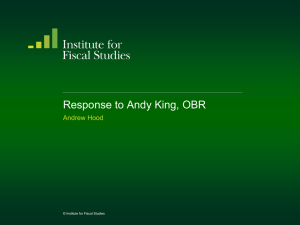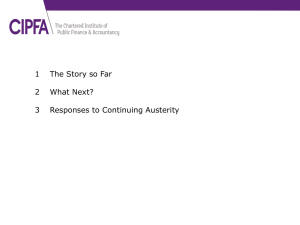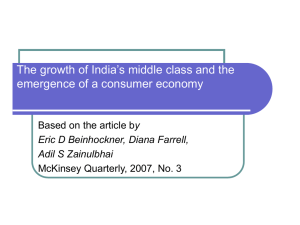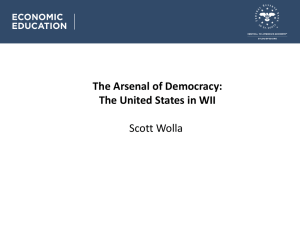fiscalchoicesfinal-130619120342-phpapp01
advertisement
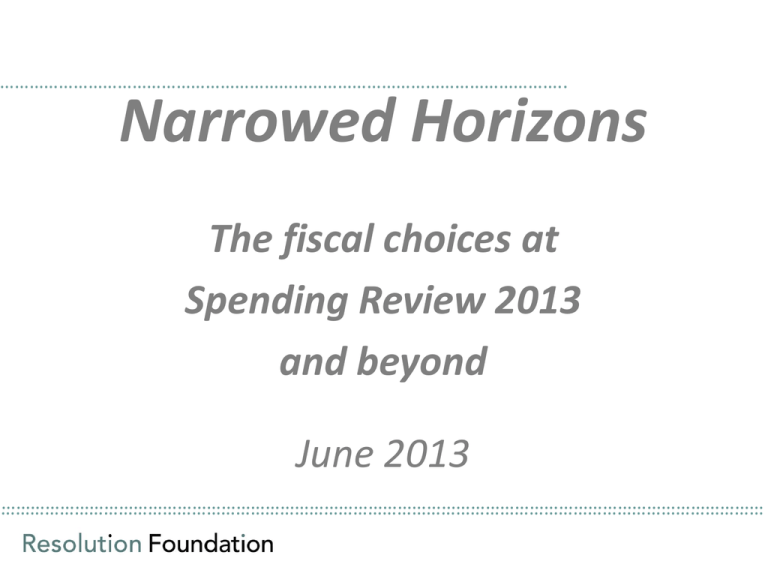
…………………………………………………………………………………………………….. Narrowed Horizons The fiscal choices at Spending Review 2013 and beyond June 2013 ………………………………………………………………………………………………………………………………………… ………………………………………………………………………………………………………………………………………… Under current deficit reduction plans the outlook for departmental spending looks bleak through to 2017-18 …………………………………………………………………………………………………….. • With balancing the current budget taking longer than previously hoped, the period of fiscal consolidation has been extended. We are at best only half way through an unprecedented period of fiscal tightening • These slides examine the implications of the approach to deficit reduction that the government has set out, in terms of what it means for the future path of public spending. It is not advocating this approach, just analysing it • Although many departments have already faced significant budget squeezes, there is much more to do before fiscal balance will be struck. Further tax rises or AME cuts are likely to be required after 2015-16. The scale of the implied further reductions in DEL that would be needed in 2016-17 and 2017-18 in the absence of such action looks incredibly – potentially inconceivably – demanding • While the debate about alternative approaches to deficit reduction is likely to continue, this new analysis considers the implications of sticking to the current strategy ………………………………………………………………………………………………………………………………………… ………………………………………………………………………………………………………………………………………… 2 …………………………………………………………………………………………………….. 1 Context for 2015-16 some done – much still to do ………………………………………………………………………………………………………………………………………… ………………………………………………………………………………………………………………………………………… Borrowing is falling as a share of GDP for eight years, mainly due to action on expenditure …………………………………………………………………………………………………….. Receipts stay at around 38% of GDP but spending falls from 47% to 41% Aim is to reduce cyclicallyadjusted net borrowing from 8.9% of GDP in 2009-10 to 0.6% in 2017-18, equivalent to a reduction of £123bn in 201213 prices PSNB figures exclude impacts of Royal Mail Pension Fund and Asset Purchase Facility Transfers. (‘Notes & Sources’) ………………………………………………………………………………………………………………………………………… ………………………………………………………………………………………………………………………………………… 4 Real terms spending will stay broadly flat but, with AME rising, DEL must fall …………………………………………………………………………………………………….. While total spending is set to be flat in real terms across the future period, AME spending is forecast to rise in the absence of any further cuts to social security In this scenario, departments would face overall cuts in DEL of around £84bn from 2009-10 to 2017-18 From 2013-14 there is a definitional shift from DEL to AME. Chart is adjusted to remove this effect. (‘Notes & Sources’) ………………………………………………………………………………………………………………………………………… ………………………………………………………………………………………………………………………………………… 5 Fiscal mandate merely requires an intention to achieve balance, but the target date keeps moving …………………………………………………………………………………………………….. Current account budget deficit peaked in 200910 at 7.8% of GDP Cyclicallyadjusted deficit was 5.5% of GDP (£83bn) and is forecast to return to balance in 2016-17, though this timeframe has moved outwards over the course of the Parliament ………………………………………………………………………………………………………………………………………… ………………………………………………………………………………………………………………………………………… 6 Though revisions to the output gap estimate have reduced the extent of the structural deterioration …………………………………………………………………………………………………….. The output gap estimate has increased significantly over recent years, meaning that deteriorations in current budget forecasts have not fed fully through to the structural budget This estimate – and all the associated fiscal trajectories – may well change again ………………………………………………………………………………………………………………………………………… ………………………………………………………………………………………………………………………………………… 7 And the supplementary target for public sector net debt is likely to be missed …………………………………………………………………………………………………….. Public sector net debt has risen from 30% of GDP in 2001-02 to 76% (£1.2tn) in 2012-13 Net debt is set to continue rising until 2016-17, peaking at 86% of GDP (£1.5tn), missing the supplementary target ………………………………………………………………………………………………………………………………………… ………………………………………………………………………………………………………………………………………… 8 DEL is due to fall by nearly 10 per cent over the current Spending Review period …………………………………………………………………………………………………….. Total DEL is set to be nearly 10% lower in real terms in 2014-15 than in 2010-11, with most of these cuts having already occurred Following large initial falls, capital allocations are set to increase in 2013-14 and 2014-15, while RDEL continues to decline From 2013-14 there is a definitional shift from DEL to AME. Chart is adjusted to remove this effect. (‘Notes & Sources’) ………………………………………………………………………………………………………………………………………… ………………………………………………………………………………………………………………………………………… 9 But protection for some areas of spending means the distribution of cuts varies significantly …………………………………………………………………………………………………….. • Spending Review 2010 protected – Schools (spending per pupil was protected in cash terms, while a £2.5bn pupil premium for disadvantaged children was expected to produce an overall real terms increase of 0.1 per cent a year) – Health (a real terms increase in NHS funding of 0.4 per cent over the period) – Overseas Development Aid (increase in ODA to 0.7 per cent of Gross National Income from 2013) • Downward revisions to the GDP deflator since SR2010 means the nominal allocations specified at the time now appear more generous in real terms • But downward revisions in GNI have allowed the aid budget to be cut compared to what was expected at the Spending Review ………………………………………………………………………………………………………………………………………… ………………………………………………………………………………………………………………………………………… 10 Real terms cuts in non-protected departments have averaged one-fifth, with some doing far worse …………………………………………………………………………………………………….. DFID is set to increase in size by one-quarter while the FCO is shrinking by half Health is one of only three departments to grow in real terms; cuts to the non-schools budget means that Education is set be cut by 7.5%, despite the protection for schools ………………………………………………………………………………………………………………………………………… ………………………………………………………………………………………………………………………………………… 11 Spending Review 2013 (covering 2015-16) will distribute further cuts to DEL …………………………………………………………………………………………………….. • Despite the savings associated with previously announced cuts to welfare, AME spend is projected to increase by 3.3 per cent in real terms in 2015-16, reaching £388bn • In the absence of any new announcements on AME cuts or tax rises, this means the implied DEL envelope is £356bn, a 2.7 per cent real terms cut from 2014-15 • The resource DEL envelope is £312bn, 2.6 per cent down on 2014-15 (the oft-quoted £11.5bn figure for resource DEL cuts is measured against a baseline that excludes projected underspends and £1.5bn of cuts set out in Budget 2013) • The capital DEL envelope is £44bn, 3.4 per cent down (though an increase in capital AME means that overall investment will fall by less) • Health, schools and ODA will remain protected (although ‘protection’ has not yet been defined this time around) ………………………………………………………………………………………………………………………………………… ………………………………………………………………………………………………………………………………………… 12 Continued protections mean that cuts will again fall unevenly …………………………………………………………………………………………………….. Final allocations are yet to be decided: some budgets are still being negotiated, with capital DEL subject to a zerobased review For illustrative purposes, if ‘protection’ means flat in real terms and all other cuts are shared equally, reductions will top 8% for some departments ………………………………………………………………………………………………………………………………………… ………………………………………………………………………………………………………………………………………… 13 …………………………………………………………………………………………………….. 2 Beyond 2015-16 finishing the job? ………………………………………………………………………………………………………………………………………… ………………………………………………………………………………………………………………………………………… Overall cuts are set to accelerate after 2015-16, implying a potential quickening in the pace of DEL cuts …………………………………………………………………………………………………….. Existing deficit reduction plans require a further £26bn of tightening by 2017-18 With no change in policy on welfare or tax, current AME forecasts imply DEL cuts of 3.8% a year, faster than in either SR2010 (2.4 per cent a year) or SR2013 (2.7 per cent) From 2013-14 there is a definitional shift from DEL to AME. Chart is adjusted to remove this effect. (‘Notes & Sources’) ………………………………………………………………………………………………………………………………………… ………………………………………………………………………………………………………………………………………… 15 Even without further protections, this would push total DEL cuts to one-third or more in key departments …………………………………………………………………………………………………….. If the resource and capital cuts were shared equally, all departments other than DfID would have shrunk by 201718 relative to 2010-11 At the extremes, FCO would have experienced a budget cut of 58%, and Communities would be 53% smaller ………………………………………………………………………………………………………………………………………… ………………………………………………………………………………………………………………………………………… 16 Maintaining the protections would force other reductions higher still …………………………………………………………………………………………………….. If schools, health and ODA were instead once again protected in real terms, overall cuts would reach 64% in the FCO, 55% in Communities and 46% in the Home Office ………………………………………………………………………………………………………………………………………… ………………………………………………………………………………………………………………………………………… 17 DEL cuts could be reduced by 1ppt for every £3.5bn raised from AME cuts or tax rises …………………………………………………………………………………………………….. Under current plans, DEL cuts will accelerate Slowing the DEL cuts to their SR2010 pace would require a £10bn policy action in terms of AME cuts or tax rises Slowing to the SR2013 pace would require £7.5bn From 2013-14 there is a definitional shift from DEL to AME. Chart is adjusted to remove this effect. (‘Notes & Sources’) ………………………………………………………………………………………………………………………………………… ………………………………………………………………………………………………………………………………………… 18 But achieving such savings would involve difficult, and potentially implausible or unpalatable, trade-offs …………………………………………………………………………………………………….. Some illustrative (not definitive) examples • Employment: restoring the claimant count to its June 2008 level of 0.9m in 201617 (rather than the 1.5m OBR forecast) would raise about £3bn from JSA alone in the following two years and significantly more once the impact on other benefits and taxes is factored in • Pensions: fixing total State Pension spending in real (GDP-deflated) terms at its 2015-16 level would raise £5.2bn in the following two years (but would break the triple-lock) • Tax credits: a 10 per cent real-terms (GDP-deflated) cut in spending on personal tax credits between 2015-16 and 2016-17 would save around £8bn over the following two years (but would come on top of £9bn annual savings already earmarked to come from tax credits by 2017-18) • VAT: increasing the standard rate by 1ppt from 2016-17 would raise in the region of £11bn over the two years (but would add to the squeeze on living standards already being felt by many) ………………………………………………………………………………………………………………………………………… ………………………………………………………………………………………………………………………………………… 19 …………………………………………………………………………………………………….. 3 Reshaping the state the changing face of DEL and AME compositions ………………………………………………………………………………………………………………………………………… ………………………………………………………………………………………………………………………………………… Departmental protections since 2010-11 mark a major shift in spending, towards health in particular …………………………………………………………………………………………………….. If protections persist postSR2013 and no new action on AME or tax occurs, the share of government spending going to health is set to rise from onequarter to onethird of total DEL, while the defence share will fall from 9.8% to 8.1% ………………………………………………………………………………………………………………………………………… ………………………………………………………………………………………………………………………………………… 21 The composition of AME is also changing, with a shift away from benefits and tax credits towards debt interest …………………………………………………………………………………………………….. OBR projections suggest that spending on benefits will comprise a smaller share of total AME by 2017-18; 48%, down from 53% in 2010-11 Rising interest rates means that debt interest is set to account for a growing share ………………………………………………………………………………………………………………………………………… ………………………………………………………………………………………………………………………………………… 22 Within social security, state pension spending is up, tax credits are down …………………………………………………………………………………………………….. State Pension and associated payments are set to increase rapidly in the coming years Working-age benefits are due to fall; tax credits are hardest hit, while JSA spending falls as the economy recovers ………………………………………………………………………………………………………………………………………… ………………………………………………………………………………………………………………………………………… 23 In the short-term, rising pension spending is mainly due to increased generosity, not demographics …………………………………………………………………………………………………….. Average welfare payments per pensioner are set to increase from £9,000 a year in 2010-11 to £9,500 in 2017-18 (adjusted using the GDP deflator) Cuts and economic recovery mean average working-age payments are falling ………………………………………………………………………………………………………………………………………… ………………………………………………………………………………………………………………………………………… 24 Both the government and the opposition have proposed a new limit on AME …………………………………………………………………………………………………….. • Budget 2013 announced an intention to introduce a “firm limit” on a significant proportion of AME, while still allowing the automatic stabilisers to operate • The opposition has announced an intention to cap “structural” aspects of welfare spending, setting three year budgets alongside future Spending Reviews ………………………………………………………………………………………………………………………………………… ………………………………………………………………………………………………………………………………………… 25 In practice, the hit from a welfare cap is likely to fall on Housing Benefit or tax credits …………………………………………………………………………………………………….. Ruling out nonsocial security payments like debt interest and public service pensions, along with the State Pension, leaves less than onethird of AME spending This mostly comprises tax credits, Housing Benefit and disability benefits From 2013-14 there is a definitional shift from DEL to AME. Chart is adjusted to remove this effect. (‘Notes & Sources’) ………………………………………………………………………………………………………………………………………… ………………………………………………………………………………………………………………………………………… 26 Though the distinction between structural and cyclical welfare spending is hard to draw …………………………………………………………………………………………………….. Simple comparisons of patterns of spending on welfare with GDP growth over recent decades suggests that some benefits appear more cyclical than others, but in truth different payments will involve both cyclical and structural elements ………………………………………………………………………………………………………………………………………… ………………………………………………………………………………………………………………………………………… 27 …………………………………………………………………………………………………….. Notes & Sources ………………………………………………………………………………………………………………………………………… ………………………………………………………………………………………………………………………………………… Notes …………………………………………………………………………………………………….. • From 2013-14, localisation of Council Tax Benefit results in a definitional shift from AME to DEL of around £4bn a year. At the same time, the retention of a proportion of business rates by local authorities results in a definitional shift from DEL to AME of some £12bn a year. Throughout this report, DEL and AME figures (including the ‘locally financed expenditure’ element of AME) are adjusted to remove the net effects of these shifts, in order to construct consistent time series. Individual department spending totals (specifically CLG Local Government, Scotland and Wales) include the switch however • The Public Sector Net Borrowing figures reported in this document exclude the effects of the one-off transfer of Royal Mail pension assets in 2013-14 (treated as negative capital expenditure of £28bn in the National Accounts). They also exclude flows associated with the Asset Purchase Facility which are projected to be positive (capital grants in the National Accounts) in the years to 2016-17 (thereby reducing PSNB) and offsettingly negative from 2017-18 to 2022-23 (thereby increasing PSNB) ………………………………………………………………………………………………………………………………………… ………………………………………………………………………………………………………………………………………… 29 Sources …………………………………………………………………………………………………….. • DWP, Expenditure Benefit Tables, Budget 2013 • IFS, “Cutting the deficit: three years down, five to go?”, May 2013 • HMT, Main Estimates 2013-14, May 2013 • HMT, PESA Budgetary Update, April 2013 • HMT, Budget 2013 (and earlier) • OBR, Public Sector Finances Databank, May 2013 • OBR, Economic & Fiscal Outlook, March 2013 (and earlier) • ONS, Public Sector Finances Update, May 2013 ………………………………………………………………………………………………………………………………………… ………………………………………………………………………………………………………………………………………… 30
